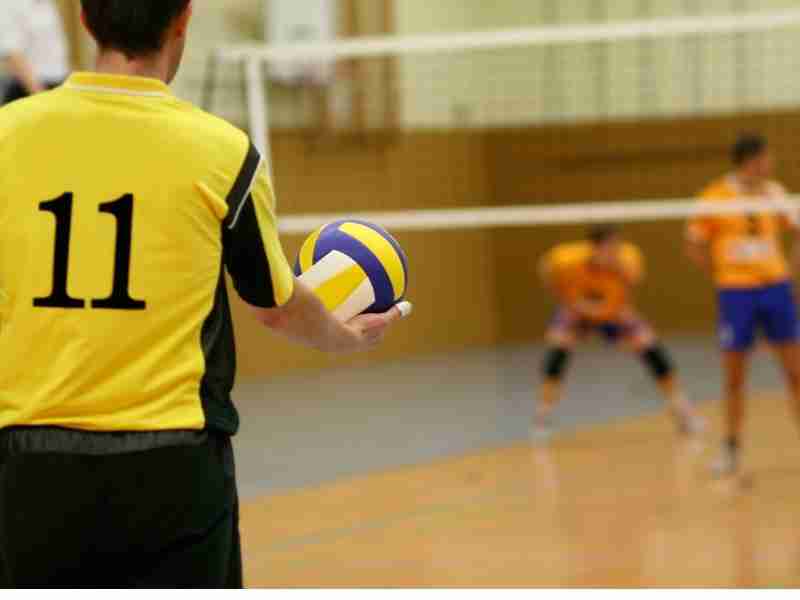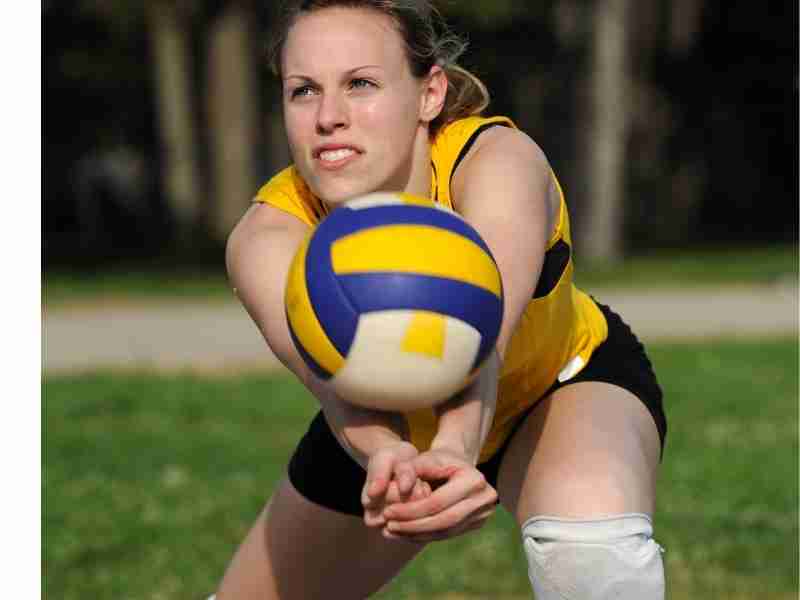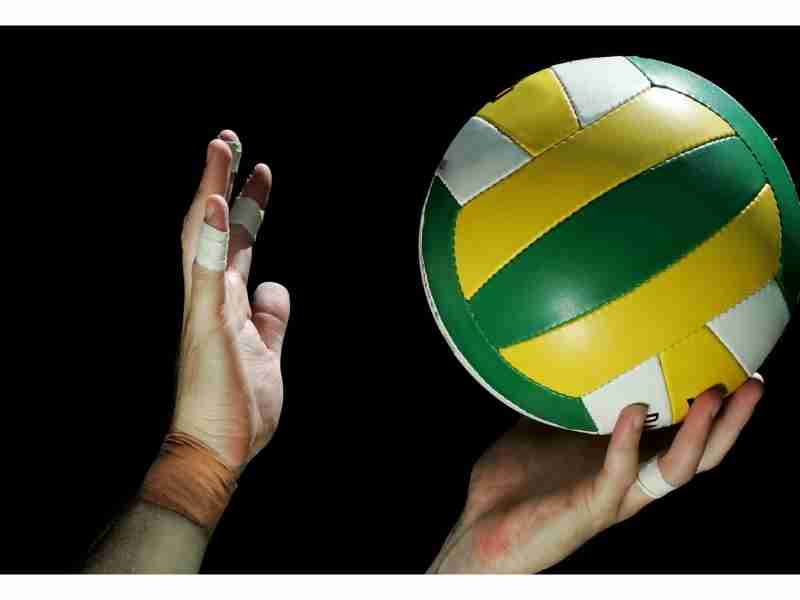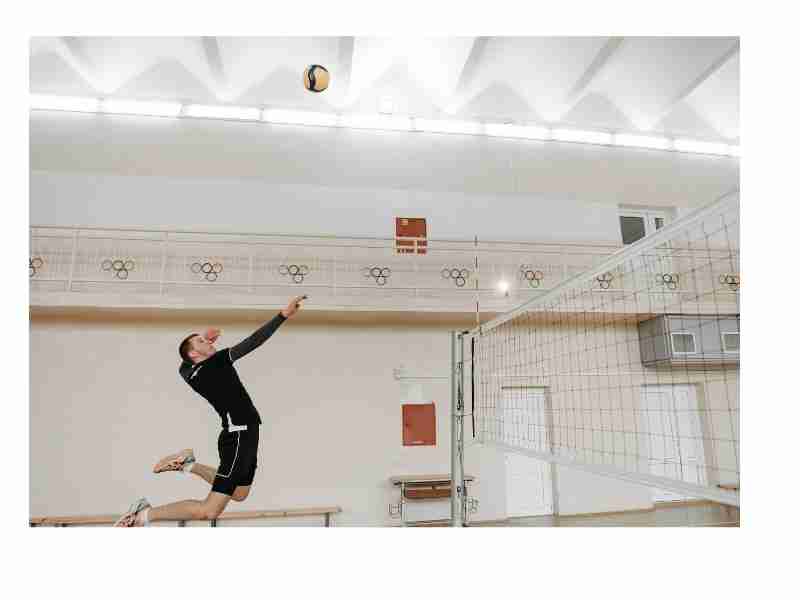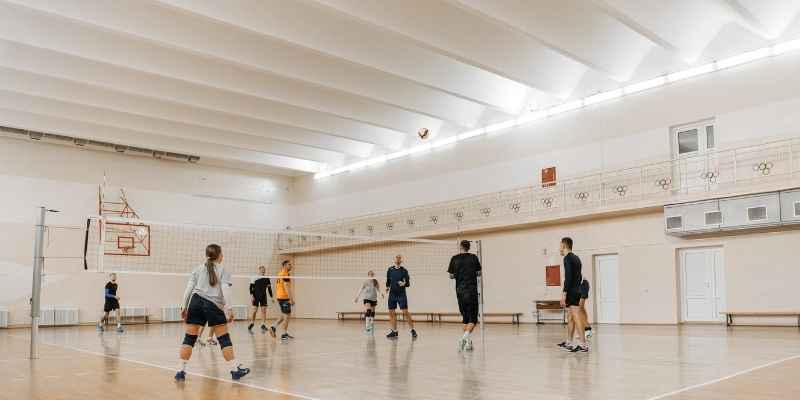
A lot of people take pleasure in playing the sport of volleyball. It can be played by anyone, regardless of age or size. Playing volleyball can be a great way to exercise and have fun. If you’re interested in playing volleyball, you should know a few things.
There are six positions in volleyball; let’s look at each position in more detail.
What Are The Volleyball Positions?
On the volleyball court, there are six positions. Setter, right-side hitter, left-side hitter, middle blocker, outside hitter, and libero are examples of these positions. The setter is the player who serves the ball to the team’s other hitters. Right, and left-side hitters are in charge of attacking the ball from the right and left sides of the court, respectively.
The middle blocker is in charge of intercepting any balls that cross the net in the middle of the court. The outside hitter is in charge of attacking balls that come over the net from the court’s perimeter.
A defensive specialist known as the libero dons a unique jersey from the rest of the team. The libero’s main duty is to recover any balls hit by the opposing team, and they are free to enter and exit the game as often as they like.
Outside Hitter
The position of outside hitter is one of the most important in volleyball. As the name suggests, outside hitters are responsible for attacking the ball outside the court. This means they must understand the game well and anticipate where the ball is going.
The outside hitter handles all the hitting, passing, digging, and serving duties. As such, they need to be well-rounded athletes with a strong work ethic.
Outside hitters have a wingspan that allows them to reach across the net. They also need to be powerful and explosive, with the ability to jump high and hit the ball hard.
Position Of An Outside Hitter
On the volleyball court, the position of the outside hitter is usually front left. After rotating to the back row, their primary defense position is generally in the middle of the back row. The front left base defense’s primary duty is to stop opposing players from spiking the ball on their net side.
The Function Of An Outside Hitter
The outside hitter is one of the three front-row positions. As the name suggests, these players typically line up outside the court, near the antennae. The primary responsibility of an outside hitter is to serve as the primary attacker, attacking balls set by the middle blockers. Outside hitters must have a strong arm and good leaping ability to succeed at this position.
Outside hitters must be able to play defense and attack, blocking shots at the net and digging up balls hit by the opposition. Outside hitters are often some of the most versatile and well-rounded players on a volleyball team because they play an essential role in the game’s offensive and defensive aspects.
Furthermore, the outside hitter is usually the left-handed batter. This player is in the best position to get a clean hit on the ball, so they are responsible for most of the team’s kills.
They must have the strength to spike the ball over the net and be agile enough to run down any balls heading towards the back line.
Qualities Of A Great Outside Hitter
Outside hitters are expected to do almost everything on the court and score most of the team’s points. For this to work, the outside hitter must be a good athlete. The most common traits of a great outside hitter are as follows:
Be quick! Outside hitters defend the volleyball by moving quickly. On offense, they hit with speed.
Reach is significant, no matter how tall or high you jump. You don’t have to be tall or jump high to block and spike in volleyball. Even average athletes can be great outside hitters if they are creative and have a long reach.
Outside hitters know a lot about volleyball. They must understand and respond to how the other team defends, blocks, and puts their shoulders.
Great outside hitters can always be counted on. If the outside hitters set by the setter are having trouble, the whole team is likely having trouble.
Volleyball Middle Hitter
Middle hitters play one of the most important positions on the court because they are tall and have the most incredible vertical range. Middle hitters must have quick reflexes and a good sense of the game to predict where the ball will be set and hit or block it.
Middle hitters need to be all-around athletes with a strong work ethic because they are essential on offense and defense.
Position Of Middle Hitter
The back-row base defense position for the middle hitter is left. They only play defense when serving because the libero usually takes their place. The libero is a specialized defensive player who wears a different color jersey to make it easier to identify them.
The middle hitter is responsible for blocking any attacks from the middle of the court. They must also be quick on their feet to defend against any spikes thrown their way.
Role Of The Middle Hitter
- Middle hitters block the opposing team’s attack.
- They could also contribute to the offense depending on the team’s strategy.
- They block the opposing team’s middle hitter but will switch positions if needed.
- They must be quick and read the opposing setter.
- If run well, the opponent will commit to the middle, freeing outside and opposite hitters.
- The middle hitter spikes to confuse the defense.
- They must be good at attacking from midcourt. This requires good footwork and powerful swings.
Qualities Of Middle Hitter
Great middle hitters possess a unique combination of physical and mental abilities.
It is pretty obvious at first glance that successful middle hitters are frequently highly tall.
As you delve deeper into the characteristics of a great middle hitter, you’ll notice that they control the net to alter the outcome of volleyball matches.
Being tall is not required for greatness, but it certainly helps greatly. Unless you have a 40-inch vertical, you’ll likely need to be one of the tallest players on your team if you’re a middle hitter.
Middle hitters are not required to be fast, but they must be swift. A quick transition from one end of the net to the other is one of the essential qualities of a great middle hitter.
Middle hitters who lack lateral agility are typically a step behind on their blocks, creating openings for opposing hitters.
The middle is a position of power. It is uncommon for middle hitters to score by bunting.
A skilled middle hitter spikes the volleyball with incredible velocity, instilling the opposing team with dread.
Middle hitters must possess strong hands every time they step onto the volleyball court. Their hands take a beating, so they must be incredibly sturdy.
Opposite Hitter
Every volleyball player knows that the opposite hitter is one of the most critical players on the court. The opposite hitter’s job is to hit the ball from the other side of the net. Their main goal is to keep the ball in play and score points for their team. The batter on the other side must be quick on their feet, have a strong arm, and be able to hit the ball with power and accuracy.
The opposing hitter hits and blocks from the right side of the volleyball net. It is an excellent position for lefties because the ball does not have to cross their body before spiking. During serve reception, the opposing hitter doesn’t pass and is seated in the back row.
Position Of An Opposite Hitter
The base defense is typically aligned in the front row on the right side of the court, opposite the setter. This position is responsible for digging up any balls hit cross-court by the opposing hitters.
In the back row, the base defense is typically aligned in the back right position, opposite the setter.
Role Of Opposite Hitter
- The right-side opposite hitter generates offense. The opposite hitter must be able to spike, tip, and block.
- Opposing hitters are frequently good blockers who keep the outside hitter at bay.
- The opposite hitter usually digs when the opposing team’s outside hitter is not set.
- The “five-ball” or “backset” is the most common attack made by an opponent.
- The offense has three net options when the opposite is in front, and the setter is in back.
- This can be effective and offer many play options.
- Their primary goal is to block attacks directed at them from the back row. Because the front row setter has only two options, back row sets are common.
Qualities Of Opposite Hitter
An opposite hitter is a player who hits the ball from across the net. Opposing hitters are typically taller than other players on the court and have strong arms. They also can hit the ball with power and accuracy. As a result, opposite hitters are often the most important players on a volleyball team.
They are responsible for scoring the most points and making the most kills. Opposite hitters typically play in the front row of the court.
A volleyball player who isn’t afraid to get their hands dirty makes a good opposite hitter. They are noticeable when they are up at the goal, and when defending, they play forcefully.
Contrary to popular belief, middle hitters are not always the tallest volleyball players. Great opposite hitters are typically enormous since blocking is the primary responsibility of this volleyball position. Keeping the opposing team’s outside hitter under control increases your team’s chances of winning.
Tipping can be helpful in some circumstances, but great opposite hitters are almost always more significant than the blocker. Therefore, they must possess the strength to put the ball down without being dug.
The opposing hitter will do a lot of blocking. They will have a challenging volleyball season if they don’t have strong hands.
When playing defense, opposing hitters must determine whether a spike is in or out.
On defense, the opposing hitters, whether a hard-line shot from the outside or a volleyball from the opposing middle, are in danger. An outside hitter must be ready and willing to take a volleyball to the face.
Volleyball’s Setter
The setter is an essential player in charge of starting the offense. The setter is the player who makes the first contact with the ball on each play and usually lines up behind the three front-row players. The setter then passes the ball to a front-row player, who spikes it over the net into the opposing team’s court.
The setter is frequently referred to as the team’s quarterback because they control the game’s tempo and bear great responsibility. Setters must have excellent ball-handling skills and coordination because they are so important. They must also be quick thinkers and make split-second decisions.
Position of Setter
The setter’s base defense position is in the front row at the front right. From this position, they can quickly move to block any shots that come their way. When they move to the back row, their primary defense position is usually the back right. This allows them to keep an eye on both the hitters and the setter.
Role of setter
- The setter looks for mismatches to increase offensive scoring chances.
- The setter tells players who set to expect before they serve. The signals could be a number or a gesture for a bic or shoot.
- They may hit the ball twice to surprise the other team.
- When defending, they block the opponent’s an outside hitter and dig. Depending on their team’s blocking strategy, they may block other attacks.
- Back row duties are similar to opposite row duties but must transition quickly to run the offense. If the setter doesn’t play defense first, points are lost.
Qualities of setter
On the volleyball court, the setter is the leader. A good setter must be able to think quickly, make quick decisions, and communicate effectively.
Setters must always be able to see the entire court and know where each player is. They must have a solid understanding of the game and predict what the opposing team will do. Setters must also be highly accurate when setting the ball.
They must be able to position the ball so that their teammates can hit it. Setters must also be capable of creating plays. They must be inventive to score points against the opposing team.
The setter is the volleyball team’s quarterback and must possess all of the same qualities as a good quarterback in football.
Volleyball libero
The libero is a defensive specialist. The libero is not permitted to serve or move to the front row like other players are. Instead, they take the field in the back row, where they are in charge of digging up attacks and maintaining possession of the ball. A team’s defensive strategy depends heavily on the libero, which is typically among the court’s fastest and most nimble players.
As teams have come to rely more heavily on defense to win games, the role of the libero has grown in significance.
Position of Libero
The base defense is typically anchored by the libero, who lines up in the back left corner of the court. This positioning gives the libero a clear view of the entire court and allows them to make quick adjustments to the defense as needed.
They play a vital role in ensuring that the defense is appropriately set up and able to react quickly to any changes in the game. As such, the libero is an essential part of any volleyball team.
Role of Libero
- Volleyball’s libero plays defense.
- Liberos receive serves and keep the ball in play.
- Liberos have excellent passing skills and are often setters in back-row formations.
- The libero lacks offensive skills but makes up for it with great defense.
- If the opposite outside is set, the libero slides back and prepares for the spike.
Qualities of libero
The libero is typically characterized as a defensive specialist. Their primary focus is on halting opposing attacks and digging up balls that have been hit into the backcourt. As such, liberos tend to be very good at reading the game and positioning themselves well to make plays.
In addition to being strong defenders, liberos also need excellent ball-handling skills. This is because they often find themselves in possession of the ball after making digs and need to be able to transition it up the court to their teammates quickly. Another critical aspect of their game is serving; liberos typically have very accurate float serves
The libero sets the good to spot a spike and act swiftly enough to get behind it. This player is also responsible for most of the communication on the court. They must let their teammates know where they are and be vocal about calling out plays.
Defensive Specialist
A player who plays defense best is called a defensive specialist in volleyball. This means that it is their job to stop the ball from going into the other team’s court and to keep it from hitting the floor in their court.
They may also be responsible for setting the ball or passing it to another player on their team. Defensive specialists usually play in the back row of the court, and they often have a good view of the entire court so that they can see where the other team is attacking from.
Position of Defensive Specialist
The defensive specialist’s job is to dig up and keep in play any balls that go over the net. They also need to be able to set up attacks for their teammates. They can’t block at the net because they are in the back row. Also, since they are not on offense, they often have more time to watch the batters on the other team and guess where the ball will go. So, they play a big part in stopping the other team’s offense and scoring points for their team.
Along with the setter, the middle blocker, the outside hitter, the opposite hitter, and the libero, the defensive specialist is one of the roles on the team. The best players at defense are those who can pass well and dig well.
Function Of A Defensive Specialist
- The defensive specialist helps out less capable players in the back row.
- This is important when the opposing team has a good hitter and blocker but a poor server.
- Opponents should use a defensive specialist once they reach the back row.
- A defensive specialist isn’t restricted like a libero.
- They can back-row attack and front-row attack from the 10-foot line.
- The defensive specialist’s versatility makes him a vital volleyball player.
Volleyball serving specialist
Before serving, the player stands behind the end line at the back of the court. A player can serve from behind this line but must not step on or over it before serving. The player must then hit the ball with their hands joined together and extended over their head.
They may not double hit the ball, let it hit any part of their body or clothing, or touch the net with any part of their body or clothing. When making a service motion, the player is permitted to take one step. After coming to a complete stop, they may then attempt to hit the ball. If a player fails to meet these requirements, it is considered a fault serve. If a player hits the ball into the net on their service attempt, it is also considered a fault.
A player may only serve two consecutive faults (double fault), after which the opposing team is awarded a point. Servers usually rotate after every point scored to distribute serving opportunities throughout the game evenly.
However, in some cases (e.g., when trailing by one point late in the game), servers may be allowed to continue serving until they commit a fault. When this occurs, it is said that they have “earned” the right to serve.
Role of Serving specialist
- They’re most likely to get a one-point ace.
- They start the rally, keep the ball in play, and help their team score.
- You must have a consistent or difficult-to-pass serve to be a serving specialist.
- Give your all on offense and defense if you’re a serving specialist.
FAQs
Is Height Important When Deciding On A Volleyball Position?
Both yes and no. Height can be a significant advantage when it comes to volleyball. Taller players have a more extended reach, giving them an advantage when blocking shots and attacking the ball. Furthermore, taller players frequently have more power, making them more effective with spikes and serves.
However, height is not the only factor influencing a player’s position on the court. Players of all heights can succeed in any position with the right skill set. A shorter player, for example, may be better at setting the ball, whereas a taller player may be better at blocking.
As a result, it is up to the coach to determine which position each player will excel in based on their abilities.
Which Volleyball Positions Are Best For Short Players?
Shorter players can be just as successful on the court, provided they know which positions to play. For example, setters are responsible for initiating the team’s offensive attacks. As such, they need a good sense of the game and the ability to make quick decisions. This makes setters well-suited for shorter players who are quick on their feet.
In general, shorter players are best suited for the setter and libero positions or defensive specialists, while taller players are better suited for blocking positions. With this in mind, any player, regardless of height, can find a role that suits their strengths on the volleyball court.
What Are The Best Positions For Tall Volleyball Players?
In volleyball, taller players have an advantage. They can reach higher to block shots and hit the ball harder.
Most middle blockers and opposite hitters are taller because they can block more shots and make it harder for the other team to score.
Outside hitters are usually in charge of hitting balls that get past the block. This means they need to have good hand-eye coordination and quick reflexes.
Also, outside hitters need to be able to hit with power so that the other team doesn’t get the ball back.
What Is The Number Of Players In A Volleyball Match?
In a game of volleyball, there are six people on each team. Each team’s six players hit a ball over the net to start the game. Then, one player on each team hits a second or spike, a serve, or a spike.
In volleyball, there are six people on each team. The front row has three players, and the back row has three more. The numbers go from left to right, beginning with one on the left. The first player hits from the left side, the second player blocks in the middle, and the third player hits from the right side. The setter is in position 4, the opposite hitter is in position 5, and the libero, specializing in defense, is in position 6.
Bottom Line
As you can see, each volleyball position has its unique set of responsibilities on the court. While it may seem like there are only a few basic positions in the game, there is much more to know to play at your best. If you’re playing volleyball or looking to improve your skills, understanding these positions and how they work together is a great place to start.


